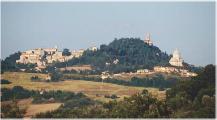 |
| Veduta di Todi |
During the 5th and 6th centuries AD the city suffered considerable from the conflict between Byzantines and Goths, which were followed by a succession of Longobard invasions until finally King Desiderius and Pope Paul I came to an agreement on the borders between the Duchy of Spoleto and the Papal States of Rome.
In the 12th century Todi proclaimed itself a free comune and joined the league of Guelph cities. The city was governed at first by consoli, then by a podestà (1201) and successively by a capitano del popolo (1255). In 1367 Todi lost its independence at the hands of Guillaume de Grimoard, the brother of Pope Urban V. A succession of aristocratic rulers governed the city from this moment onwards (the Malatesta of Rimini, Braccio di Fortebraccio da Montone, Francesco Sforza, the Anjou of Naples). The reforms introduced by Pope Martin V included Todi in the Papal States, under whose dominion it remained uninterruptedly – with the exception of a period of Napoleonic rule during which it controlled a sizeable “arrondissement” that included Amelia, Orvieto and even Acquapendente near Viterbo – until Italian unification.
 |
| Piazza del Popolo |
The Umbrian-Etruscan fortifications of the city, also built in blocks of travertine, are still visible in more than one place. The Roman fortifications included a larger area and were followed by an even larger circle of Medieval walls erected in 1244. This last circle of walls is still largely intact, with its towers and three access gateways, Porta Romana, Porta Amerina or Fratta and Porta Perugina.
The road that encircles the walls of Todi leads to the church of Santa Maria della Consolazione. Work on the construction of this impressibe monument, which stands on the site of an intensely worshipped chapel, began in 1503 but was not completed until a century later. A host of illustrious names have been credited with the design of this building, including Bramante, Antonio da Sangallo the Younger and Cola di Matteuccio da Caprarola. Recent documents indicate that the project was probably the work of Bramante. The building works certainly attracted an equally notorious array of collaborators, however, such as Peruzzi, Sanmicheli, Vignola, Galeazzo Alessi, Ippolito Scalza. The greek cross, Renaissance plan of the church features three polygonal apses and a semi-circular apse. 56 windows bring considerable light to the interior, which gains an added sense of loftiness from the high central dome. A fresco credited with miraculous powers hangs above the main altar. It depicts the 'Maestà and is 15th century, taken from the chapel that once stood on the same spot.
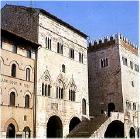 |
| Palazzo del Capitano |
The poet and friar Jacopone da Todi (1230-1306), one of the first companions of St Francis, is buried in the crypt below.
The first circle of Roman city walls are clearly visible if one passes along the left side of the church, under the convent that stands behind the construction. The street that leads from Porta Libera ends at the public gardens in Piazza IV Novembre. The gardens stand on an area that was once occupied by the Rocca Albornoziana, built by order of Cardinal Albornoz 1373 after having razed to the ground the western district of Todi. In 1503 the fortress suffered the same fate at the hands of the local population.
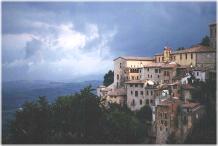 |
| Panorama diTodi |
The street continues to Via Roma. To the right, after passing under Porta Catena starts the 13th century Borgo Ulpiano area that stretches until Porta Romana. To the right of this gate there is the church of San Nicolò de Criptis, founded by the Benedictines in the 12th century above what had been the cavea of the Roman amphitheatre and subsequently enlarged in the 14th century.
To the left of Porta Romana stands the church of San Filippo Benizi, founder of the Servi di Maria order, who died in 1285 in the fomer convent of the Serviti order that was given to the Sisters of Claire in 1595.
Outside Porta Romana stands the greek cross structure of the Chiesa del Crocifisso, built by order of Bishop Angelo Cesi in 1591-95 to a design by Valentino Martelli. The final stage of the works were carried out under the supervision of Ippolito Scalza.
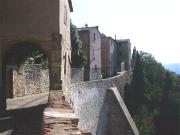 |
| Le Mura |
The church of San Carlo stands immediately after the square. Originally consecrated to St Ilarius, mention of this church appears in records as early as 1118. No less than four bishops were present in 1249, when the church was renovated and reconsecrated. The Fonte Scarnabecco, a little further on, is a washing fountain built by the Scarnabecco podestà of Bologna in 1241 as part of a project to ensure that the city had sufficient water.
After the church of Santa Prassede, rebuilt in the 14th century, and the gate that bears the same name, the Borgo Nuovo quarter of Todi is built steeply downhill. The buildings of the monastery of the Sisters of Claire stands on the right. An interesting iconographic discovery was made here in 1975 when a 1346 fresco depicting sould in Purgatory was brought to light. This is one of the earliest known depictions of Purgatory and is taken from a vision received by the Irish bishop St Patrick.
Returning upwards towards Piazza del Popolo, Palazzo del Vignola stands on the right hand side of the street shortly before the Duomo. One of Italy's most important and established antiques fairs is held here each April.
The street continues, flanking the cathedral, and ends up in Piazza del Popolo, known also as Piazza Grande or Maggiore. This is the historic heart of Todi and one of the finest Medieval squares in Italy, surrounded on all sides by public buildings and the facade of the cathedral itself.
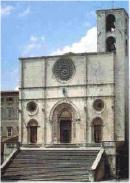 |
| Cattedrale o Duomo dedicato a S. Maria Assunta |
A passageway on the left flank of the building leads through a doorway designed by Vignola (although modified in 1762) to the bishop's palace. This magnificent building was erected by order of Bishop Angelo Cesi in 1593. The interior is decorated with frescoes by Andrea Polinori and Ferraù Fenzoni (16th and 17th century.). The building opposite, designed by Antonio da Sangallo the Younger in the 16th century, is Palazzo Cesi, which functioned as the private residence of the bishops Paolo Emilio, Federico and Angelo Cesi.
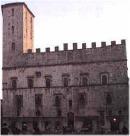 |
| Palazzo dei Priori con la Torre trapezioidale |
A single flight of steps that cuts diagonally across the arches of the loggia, leads up to the first floor of both this building and the next door Palazzo del Podestà, or del Popolo. Built between 1214 and 1228, Palazzo del Podestà is one of the oldest buildings of its kind in Italy. The guelph crenellations are early 20th century additions. The ground floor is made up of a large chamber divided by two naves. Originally this would have been open on all four sides and used as a market. The first floor is occupied by the Sala delle Pietre (formerly the Sala del Consiglio Generale) and now houses the collection of Roman architectural fragments unearthed locally that make up the Museo Lapidario. The first floor of the adjacent Palazzo del Capitano del Popolo is taken up by the Sala del Capitano del Popolo, with a number of remnants of Medieval fresco work including a fine 14th century Crucifix. The third floor, added at the end of the 13th century, houses the Pinacoteca Civica and the Museo Etrusco-Romano.
The Pinacoteca contains a number of detached 14th and 15th century frescoes, along with church furnishings, 12th- 15th century examples of majolica, ceramic and goldwork. The collections of paintings housed here includes the 'Incoronation of the Virgin', by Giovanni di Pietro (known as lo Spagna, 1507-11).
The Museo Etrusco-Romano houses every day objects, coins and a variety of other material unearthed during archaeological digs carried out in the surrounding area.
 |
| il Teatro di Todi |
In Piazza Garibaldi, opposite the Palazzo del Popolo, stands another Palazzo Atti (now Pensi), built in 1552 and initially the property of the same family that owned the other palazzo in the main square.
As well as hosting the Rassegna Antiquaria d’Italia, for some years now Todi has been organising the Todifestival in August-September, featuring international standard ballet, music, cinema and theatre. The Mostra nazionale dell’artigianato e del design takes place in September/October).








